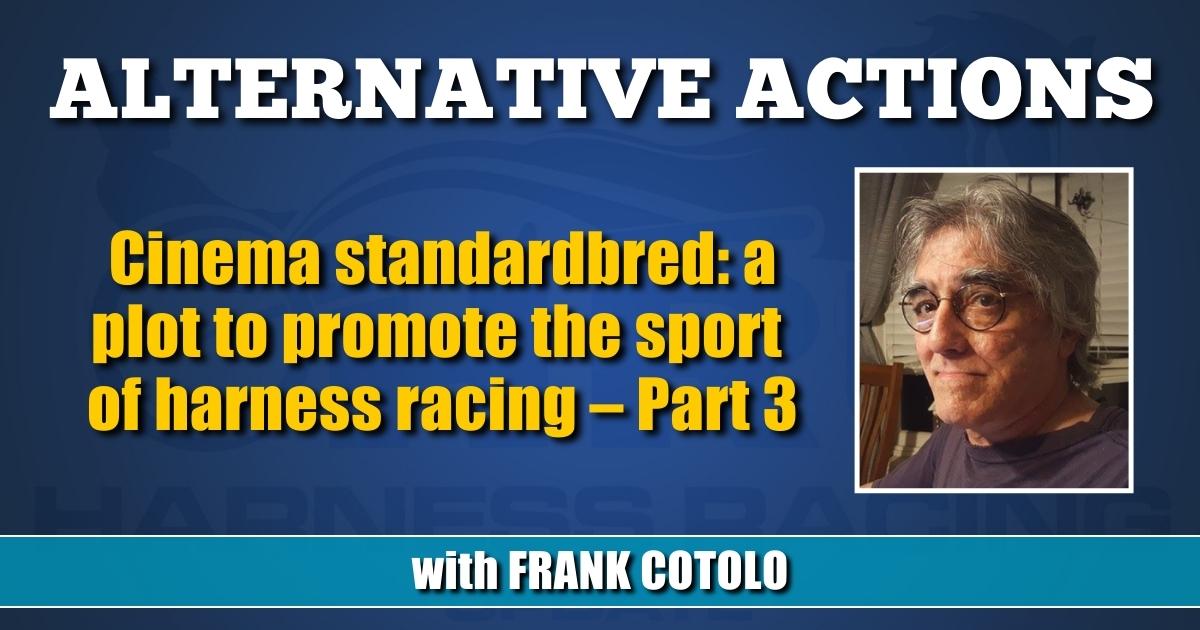Cinema standardbred: a plot to promote the sport of harness racing – Part 3
by Frank Cotolo
Alternative Actions (AA) continues its series developed to offer the solution that has the best chance to change the nature of the film industry’s ambivalence towards harness racing and perhaps inspire someone to pioneer a project that could be the most successful promotional tool standardbred racing ever utilized.
Part 1 is here.
Part 2 is here.
In 1956, Hollywood symbolically murdered horse racing as a relevant scenario for any genre of film with the United Artists release of a dark crime drama titled “The Killing.” Though I doubt if young screenwriter/director Stanley Kubrick had any such goal in mind, his interpretation of Lionel White’s novel delivered a blatant metaphor that there will always be greener pastures for screen stories to be placed upon than racetracks featuring any animal breed.
The film title itself is a metaphor (the novel’s title was “Clean Break”); a killing is slang for a successful, robust crime. Plot-wise, pulling off the story’s killing involves a dramatic distraction — the assassination of a thoroughbred while it is racing
The gang leader concocts the robbery of $2 million, which he measures as one day’s expected total receipts from fictional Lansdowne Racetrack (filmed at Bay Meadows in San Mateo, CA). He hires a rifle sharpshooter and gives him specific instructions: he must pull the trigger and shoot to kill the horse leading around the first turn in the high-level stakes race featured on the racing program. (The audience can only speculate the gang leader is also a handicapper). While instructing the shooter, the gang leader closes the deal by convincing the gunman the task is no big deal and it might not even get him in trouble if caught.
“You shot a horse,” the gang leader says. “It isn’t first-degree murder, in fact it isn’t even murder, in fact, I don’t know what it is.”
A critic wrote that “The Killing” was “a perfect film with the perfect cast, the perfect script, perfect dialogue, perfect performances and perfect direction.” It was also a perfect subconscious message of doom for screenplays: Horse racing in a movie script as a backdrop or an immediate stage is toxic.
THE WRITE STUFF
Horses themselves were not considered toxic in movies, however. With television as a second platform, movie studios continued to generate product based upon what trended in pop-culture. Major Hollywood movie companies as well as up-and-coming independent ones gave horses plenty of work in the 1950s and ‘60s, mostly because horses were imperative elements for productions involving the big TV trend of those decades–Westerns.
Western-oriented screenplays needed horses and sometimes made popular characters out of some. Still, the likes of Trigger, Silver and Flicka were second bananas to the actors playing The Lone Ranger, The Range Rider, Annie Oakley and Cheyenne. Even John Wayne, already a major star, overshadowed his stallion and stole the name of his horse, Duke.
At the same time at raceways across North America, harness racing was covered daily in the sports sections of newspapers but the community of standardbreds had no business in screenplays. Even though popular actors praised standardbreds and supported the sport were uninterested and in no position to experiment writing a movie where newsworthy trotters and pacers Bye Bye Bird, Nevele Pride or three-time Harness Horse of the Year Bret Hanover performed.
James Cagney admitted his love of standardbreds in his autobiography “Cagney On Cagney.” The Oscar-winning actor owned and drove harness horses as a hobby and trained them on his Massachusetts farm. He wrote about the beauty of them. “I cry at horse races where I look at total effort,” he said. Cagney could have commissioned a script addressing the theme of his affection for the horse in harness but retired and left Hollywood behind.
Mickey Rooney is well known later in his career for playing a race-torn jockey in the adaptation of Walter Farley’s “The Black Stallion.” Rooney loved standardbreds (I saw him often at Hollywood Park) but even with that film’s success nothing happened concerning a standardbred-oriented story.
A fascinating sidebar to that movie is the emerged stardom of the main horse in the title role (there were four horses in all). It was a Texas-bred Arabian named Cass Ole. He toured many racetracks as a promotion for the film. I met Cass Ole in the 1980s at Longacres Racetrack in Seattle and I learned his white legs and a star on one were painted black for his role.
In Part 4 of this series I address the standardbred-screenplay predicament, how it misfired and can be solved.
Have a notebook handy.

















